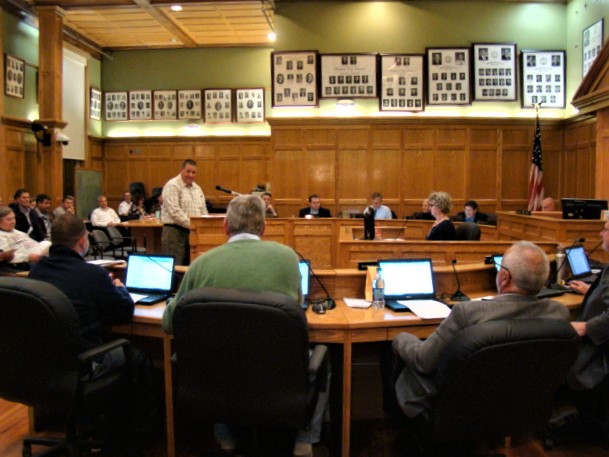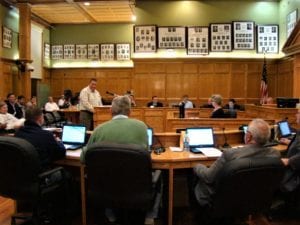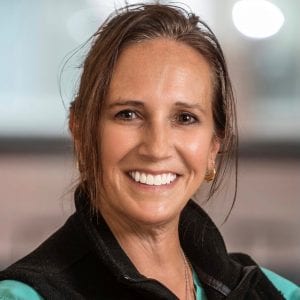WESTFIELD – Department of Public Works Director David Billips reported on the status of water filtration at the Oct. 17 City Council meeting, as requested by Ward 1 Councilor Mary Ann Babinski, chair of Public Health and Safety.
He also answered several questions posed by councilors to the Water Commission.
Billips said the City currently maintains a website specifically to address this issue and any updates are posted there immediately. He said when Wells 7 and 8 go online, the public and news outlets will be notified along with a news flash bulletin posted on the City’s main website. This will be followed up with a notification to all rate payers in their quarterly billing.
When asked how much of the two water bonds — one for $5 million and One for $13 million – had been spent, and on what, Billips broke down the two bonds.
Of the $5 million dollar bond, $1.7 million to date was spent on design, engineering and procurement for a new water tank on East Mountain Road, and for temporary treatment and work at wells 7 and 8. He said on Oct. 17, the city opened the bid for the water tank, at $2.86 million, lower than expected, which leaves $486,000 for contingency for the water tank.
Of the $13 million dollar bond; $4.4 million was spent on construction of the Owen District Water Treatment Plant for Wells 7 and 8; with another $1.3 million encumbered for construction. $600,000 was spent on design for the plant for Wells 7 and 8, with $220,000 encumbered. $398,000 was spent for design for a plant at Wells 1 and 2. $6.1 million remains in the bond, Billips said.
When asked if there have been any changes to the plans presented for the bond, Billips said there have been no changes to the filtration capacity or tank sizes from the original design for the Owen District Road Plant project. He said there were field adjustments to pipe layout, construction geometry, and other items as expected in a project of this size, but none that impact the designed filtration mechanisms or capabilities.
Billips said the Owen District Road Plant for Wells 7 and 8 is 90% complete, with most of the work remaining on the building itself. He said the Dry Bridge Road Water Treatment Plant for Wells 1 and 2 is in the permitting phase of design.
When asked how much funding has been set aside for Granular Activated Carbon change out; Billips said $120,000 per year for carbon was projected based upon an average throughput of 1,100 gallons per minute for the filtration of the wells. He said full scale results may vary from this laboratory-scale projection. Billips also noted that funding is an annual budgetary item, and cannot be set aside but must be included in the annual budget.
Billips said after Well 7 and 8 bench scale testing, a service life of 11 months was projected based on an average throughput of 1,100 gallons per minute. But he said this would equate to 580 million gallons a year, almost 3 times the annual average output of these wells.
Billips said carbon change-out will be scheduled when PFAS concentrations are detected within the filter.
He said current concentrations at the 50% sample port at Well 2 have all been below the detection limit for all PFAS compounds. He said Well 2 has run 150 million gallons without any break through, even in mid-point. He said the department is looking at two or three years before needing to change out the carbon.
Billips also reported that during 2019 testing of the new plant, PFAS concentrations in Well 7 and Well 8 have been monitored. The influent PFAS levels are consistent with PFAS levels observed in 2016 and prior. The Well 2 data have shown that GAC is effective for removing the PFAS compounds present, and the influent concentrations are extremely consistent.
In response to the question regarding plans in place to address premature or total GAC failure, Billips said, “I don’t even know what that means,”
He said premature or total GAC failure is not expected given the successful performance of the GAC filter at Well 2, so change out can be responsive to the actual conditions found, not scheduled based on projected or estimated timelines.
“The GAC vessels are arranged in a lead-lag configuration, meaning that water from the wells enters the top of the lead vessel, flows downward contacting with the GAC bed, and then is directed upward to the top of the lag vessel where water flows downward contacting with the second GAC bed. Each vessel individually is designed to fully treat to non-detect for all PFAS compounds. Given the redundancy and state-required monitoring, systems are in place to avoid a `total GAC failure’ scenario,” Billips said.
To the question of insight gained from the temporary filtration at Well 2, Billips said there have been some valve adjustments or additions at the Owen District Road Plant given operational lessons learned at Well 2. He said the GAC filter at Well 2 has treated over 150 MG of water, with no detectable concentration of any PFAS at the 50% bed depth sample port.
“We’ve almost run an average of one year of water on Well 2,” Billips said, adding that testing shows “exactly what we expected it to be.”
Babinski, City Council President Ralph J. Figy, Ward 4 Councilor Michael Burns and At-large Councilor Matthew Emmershy thanked Billips for coming in and answering the questions, with Emmershy adding, “People at home can get some answers.”
Billips invited all councilors to come and take a look at the Owen District Road Plant.









